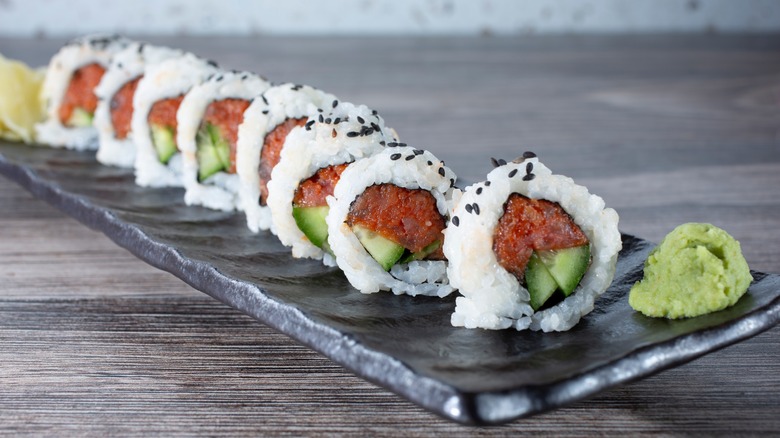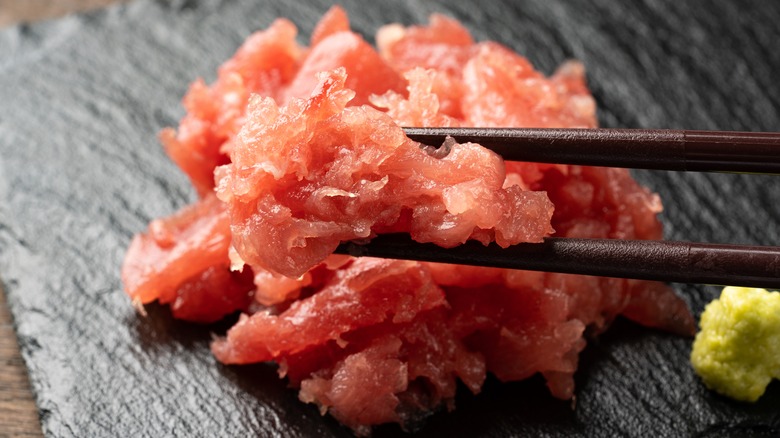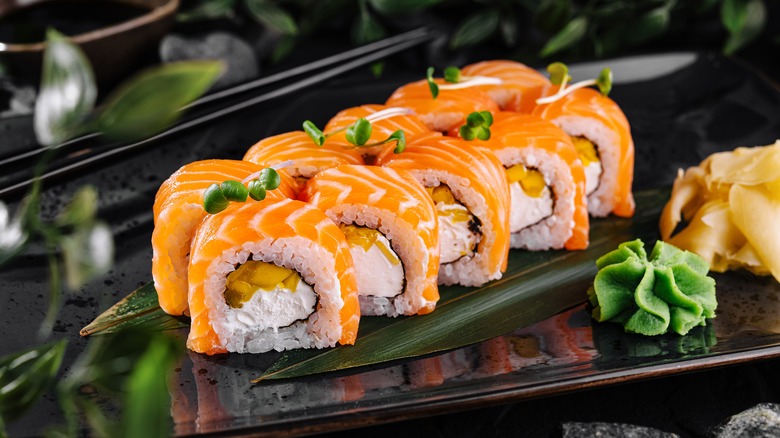Before You Eat That Spicy Tuna Roll, You Need To Learn About Tuna Scrape
A nationwide salmonella outbreak is always cause for concern, but one that occurred in the U.S. in 2012 created particular worry for anyone with an appetite for sushi. The outbreak, which spread to 28 states and the District of Columbia, was linked to raw yellowfin tuna distributed by a California importer. In April 2012, the FDA announced that the company Moon Marine USA Corporation was voluntarily recalling more than 50,000 pounds of one of its products: frozen raw fish called "tuna scrape," or meat scraped from around the fishes' backbones, that had been used in spicy tuna rolls and served around the country.
This outbreak was likely many Americans' introduction to the idea of tuna off-cuts, which look "like a ground product," according to the recall notice (via CT.gov). Combined with the fairly unappealing label "tuna scrape," these descriptions earned the product comparisons with another questionable protein: the ammonia-treated beef byproduct known as "pink slime," which is sometimes added as cheap filler to fast food burgers. But the comparison might not totally hold up. Known by another name, nakaochi, the meat from around the ribs and back of a tuna is a prized part of the fish — it's sold as a delicacy in Japan, and it's not intrinsically more dangerous than other kinds or cuts of raw fish. So, it's complicated. We're here to break it down for you.
Is tuna scrape the same as pink slime?
Tuna scrape is not particularly similar to pink slime (which many of us are probably still eating). Pink slime is technically known as lean, finely textured beef, or LFTB; it's made by collecting trimmings from meat-processing plants, separating protein from fat, then taking that lean protein and decontaminating it with ammonia gas before adding it to ground beef. Incidentally, 2012 was also the year pink slime gained notoriety via an ABC News exposé, though the topic remains unsettled: In essence, proponents argue LFTB is a safe, affordable product and that ammonia is used commonly in food processing, so it's not a cause for alarm in itself.
Tuna scrape is not nearly so industrial as pink slime. It's just the (especially tasty) flesh that's scraped off of tuna bones once the larger fillets have been removed. This could happen at the fish-processing plant, or it could happen behind the sushi counter. In the case of the 2012 outbreak, sussing out the source of the salmonella was difficult, as its spread didn't really seem to have much to do with the particular type of tuna infected. Elsewhere, tuna scrape has maintained many fans. One Hokkaido company, Hokkaido Uni Shop, sells sashimi-grade nakaochi for $35.95 per ½ pound, hailing the meat's "rich marbling," "buttery texture," and "exquisite taste." Some high-end restaurants in places like New York even let diners scrape flesh from the tuna bones themselves.
What are the risks of eating raw fish, generally?
When news organizations reported on the 2012 salmonella outbreak, this was basically the takeaway: No matter what part of the tuna your sushi comes from, there are risks associated with eating raw fish, since exposure to heat — i.e., cooking — kills many food-borne pathogens. There's good reason folks with compromised immune systems, including pregnant people, may want to steer clear of sushi: While many fish are sold as "sushi-grade," this label is unregulated, so it doesn't actually mean much. And there isn't much oversight ensuring that sushi chefs, for instance, are flash-freezing their fish to kill potentially harmful parasites.
Those parasites, meanwhile, are a growing problem: The incidence of one kind of aquatic worm found in sushi, the herring worm, has increased a mind-boggling 283 fold since the 1970s. After making its way into the intestines, this worm causes symptoms that resemble food poisoning. The good news? Raw fish are less likely to have salmonella than, say, chicken or beef, and fish remains a healthy and often sustainable source of protein. Plus, sushi is delicious — especially if you're not drowning it in soy sauce. Just stick with reputable restaurants, as trained chefs can spot worms and take other precautions before diners might encounter a problem. And, as always, it's good to know where your food comes from — you can more easily see whether your local fishmonger keeps a clean shop than an industrial processor halfway around the world.


